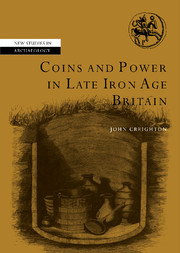Book contents
- Frontmatter
- Contents
- List of figures
- List of tables
- Preface
- Acknowledgements
- List of abbreviations
- Note on translations used
- Introduction
- 1 The Middle to Late Iron Age transition
- 2 Coin and the representation of individual authority
- 3 The Southern and Eastern kingdoms
- 4 Classical imagery and ideology in Britain
- 5 The location of Britain in the Roman world
- 6 Legends and language
- 7 Dynasties and identities
- 8 Conclusion and epilogue: from Britain to Britannia
- Appendix: A brief introduction to Iron Age coinage in Britain
- References
- Index of coin types
- General index
- NEW STUDIES IN ARCHAEOLOGY
4 - Classical imagery and ideology in Britain
Published online by Cambridge University Press: 22 September 2009
- Frontmatter
- Contents
- List of figures
- List of tables
- Preface
- Acknowledgements
- List of abbreviations
- Note on translations used
- Introduction
- 1 The Middle to Late Iron Age transition
- 2 Coin and the representation of individual authority
- 3 The Southern and Eastern kingdoms
- 4 Classical imagery and ideology in Britain
- 5 The location of Britain in the Roman world
- 6 Legends and language
- 7 Dynasties and identities
- 8 Conclusion and epilogue: from Britain to Britannia
- Appendix: A brief introduction to Iron Age coinage in Britain
- References
- Index of coin types
- General index
- NEW STUDIES IN ARCHAEOLOGY
Summary
From the mid-second century BC, coin became a familiar sight amongst the British elite and possibly a broader audience as well. People got used to how it looked and what it felt like. Whilst we can only guess at what they knew, they probably understood what the images stood for and what they symbolised. They understood the social function and role which coinage was meant to fulfil. The serial tradition meant that whilst the image might vary slightly from issue to issue, one knew roughly what to expect. Even the shift in the imagery beginning with British Q and L maintained the Apollo/Horse image. When inscriptions appeared on coins for the first time, they were slotted in around the serial images (Commius, Phase 6). However, when his ‘son’ arrived in Phase 7, all that changed.
Tincomarus' first issues were almost identical to those of Commius, and continued the serial imagery. But the images on his subsequent coinage marked a radical shift in the entire aesthetic and language of coin. For the first time we get clear, unambiguous classical imagery on coin (Stage 3: Fig. 2.3). This was no subtle alteration of coin types; the advent of these new motifs marked an abrupt alteration from the continuity of serial tradition which had hitherto existed. The effect was as radical as if one of the Enigma Variations had ventured into the realms of atonality, or Columbo had put on an Armani suit.
Each new image demanded attention.
- Type
- Chapter
- Information
- Coins and Power in Late Iron Age Britain , pp. 80 - 125Publisher: Cambridge University PressPrint publication year: 2000



